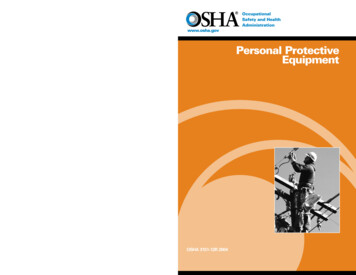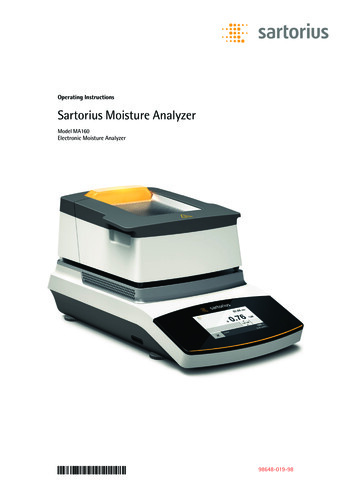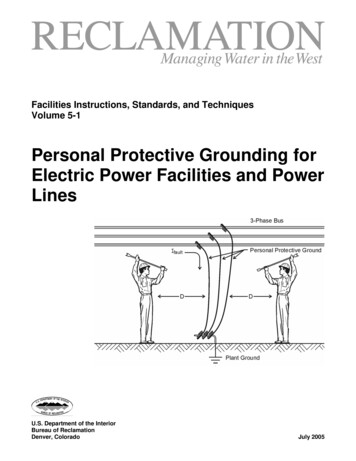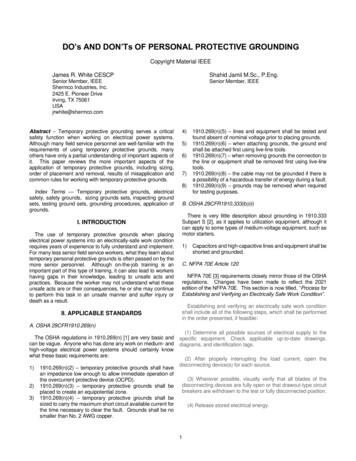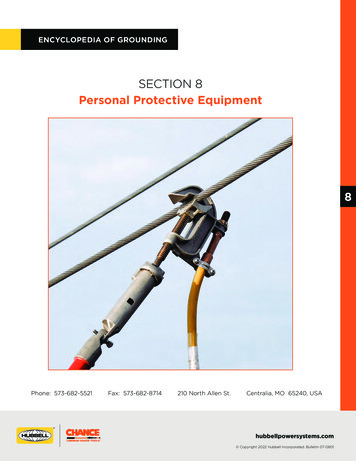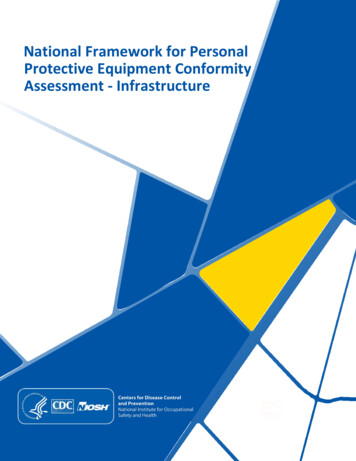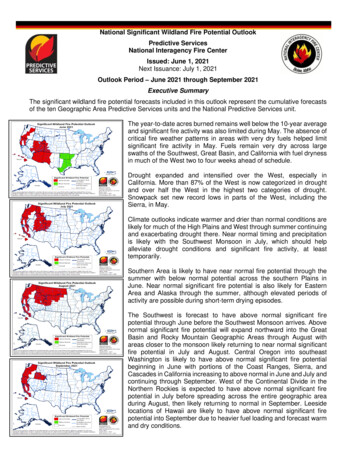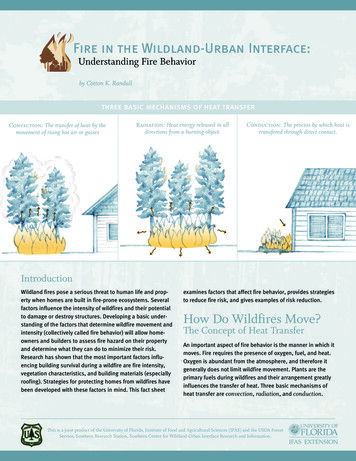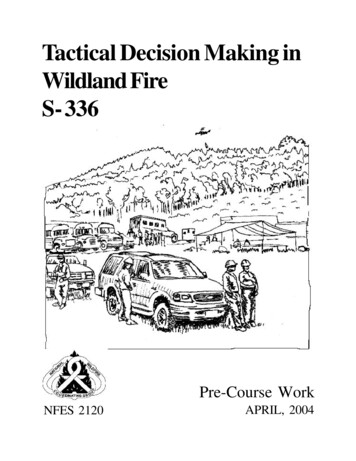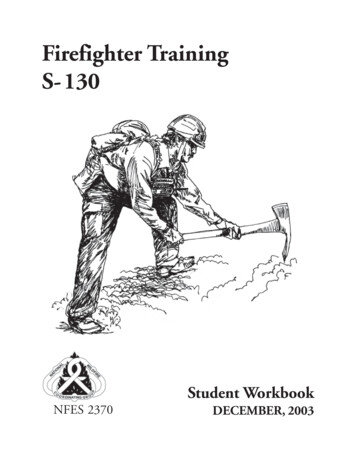
Transcription
System Assessment and Validation for Emergency Responders (SAVER)Wildland FirefighterPersonal Protective Equipment(PPE) Selection GuideJune 2014Prepared by U.S. Army Natick Soldier Research, Development, and Engineering CenterApproved for public release; distribution is unlimited.
The Wildland Firefighter Personal Protective Equipment (PPE) Selection Guide wasfunded under MIPR N6523613MP00227 from the Space and Naval Warfare SystemsCenter Atlantic on behalf of the U.S. Department of Homeland Security, Science andTechnology Directorate.The views and opinions of authors expressed herein do not necessarily reflect those of theU.S. Government.Reference herein to any specific commercial products, processes, or services by tradename, trademark, manufacturer, or otherwise does not necessarily constitute or imply itsendorsement, recommendation, or favoring by the U.S. Government.The information and statements contained herein shall not be used for the purposes ofadvertising, nor to imply the endorsement or recommendation of the U.S. Government.With respect to documentation contained herein, neither the U.S. Government nor any ofits employees make any warranty, express or implied, including but not limited to thewarranties of merchantability and fitness for a particular purpose. Further, neither theU.S. Government nor any of its employees assume any legal liability or responsibility forthe accuracy, completeness, or usefulness of any information, apparatus, product, orprocess disclosed; nor do they represent that its use would not infringe privately ownedrights.Photos are provided by the Federal Emergency Management Agency (FEMA) News Photo,unless otherwise noted.
FOREWORDThe U.S. Department of Homeland Security (DHS) established the System Assessment andValidation for Emergency Responders (SAVER) Program to assist emergency respondersmaking procurement decisions. Located within the Science and Technology Directorate (S&T)of DHS, the SAVER Program conducts objective assessments and validations on commerciallyavailable equipment and systems, and develops knowledge products that provide relevantequipment information to the emergency responder community. The SAVER Program missionincludes: Conducting impartial, practitioner-relevant, operationally oriented assessments andvalidations of emergency response equipment; and Providing information, in the form of knowledge products, that enablesdecision-makers and responders to better select, procure, use, and maintain emergencyresponse equipment.SAVER Program knowledge products provide information on equipment that falls under thecategories listed in the DHS Authorized Equipment List (AEL), focusing primarily on two mainquestions for the responder community: “What equipment is available?” and “How does itperform?” These knowledge products are shared nationally with the responder community,providing a life- and cost-saving asset to DHS, as well as to Federal, state, and local responders.The SAVER Program is supported by a network of Technical Agents who perform assessmentand validation activities. As a SAVER Program Technical Agent, the U.S. Army Natick SoldierResearch, Development, and Engineering Center (NSRDEC) has been tasked to provideexpertise and analysis on key subject areas, including personal protective equipment (PPE), rapiddeployment shelters, and shelf stable food, among others. In support of this tasking, NSRDECprepared a guide for the selection of wildland firefighter personal protective equipment, whichfall under AEL reference number 01LE-02-BDUS titled Specialized Clothing, NFPA 1975 orNFPA 2112.Visit the SAVER website on First Responder.gov (http://www.firstresponder.gov/SAVER) formore information on the SAVER Program or to view additional reports on PPE or othertechnologies.i
POINTS OF CONTACTSAVER ProgramU.S. Department of Homeland SecurityScience and Technology DirectorateFRG Stop 0203245 Murray LaneWashington, DC 20528-0215E-mail: saver@hq.dhs.govWebsite: http://www.firstresponder.gov/SAVERU.S. Army Natick Soldier Research,Development, and Engineering CenterWarfighter Directorate15 Kansas StreetNatick, MA 01760-5000Website: http://nsrdec.natick.army.milSpace and Naval Warfare Systems Center AtlanticAdvanced Technology and Assessments BranchP.O. Box 190022North Charleston, SC 29419-9022E-mail: ssc lant saver program.fcm@navy.milii
EXECUTIVE SUMMARYThis SAVER Selection Guide provides information to assist fire departments in optimizing theselection of their personal protective equipment (PPE) clothing system to maximize theprotection and performance of the wildland firefighter (WLFF). This selection guide provides anoverview of current and emerging WLFF PPE products, technologies, designs, materials,standards, and testing methodologies. This guide also discusses the effects of layering garmentsand the use of base layer garments on system performance. Using this information and theproposed selection process can optimize the selection of WLFF PPE to reduce the probability forinjury and improve WLFF operational performance.The selection of WLFF PPE clothing appears very straightforward since most WLFF PPE iscertified to National Fire Protection Association (NFPA) 1977, Standard on Protective Clothingand Equipment for Wildland Firefighting. However, WLFF PPE garment configurations andprotection performance requirements can vary greatly between different fire departments. Theselection of a poorly configured WLFF PPE garment system can actually increase the likelihoodof injury.The purpose of WLFF PPE is to provide protection against external thermal threats to preventburn injuries and transfer internally generated heat to minimize heat stress injuries. When thelevel of thermal protection is increased, typically this causes a decrease in the ability to transferinternally generated heat. Consequently, increasing protection against one hazard can create anincreased vulnerability to the other hazard. In wildland firefighting, most injuries to firefightersare due to heat stress, not burn injuries. Balancing the level of protection against these twothreats is the most critical consideration when selecting WLFF PPE.This selection guide will describe the interaction between garment configuration and materialperformance so that decision makers can better understand this interaction when configuring andselecting WLFF PPE that is optimized for their operational requirements.This proposed process for the selection of WLFF PPE utilizes a system level approach tocombine garment design and configuration, base layer garments, and new materials technologiesto improve protection and operational performance. Using this approach to select WLFF PPEcomponents will optimize the system for protection against both burn and heat stress injuries andmaximize firefighter operational performance.iii
TABLE OF CONTENTSForeword . iPoints of Contact . iiExecutive Summary . iii1. Introduction . 12. Technology Review . 22.1 Current WLFF PPE Technologies and Test Methods. 22.2 Emerging WLFF PPE Technologies and Test Methods . 42.3 Standards and Regulations . 63. PPE Selection Considerations . 83.1 The Effects of Garment Configuration . 83.2 The Effects of Base Layer Garments . 93.3 New High Performance Fabrics . 104. Selection Process . 114.1 Step 1: Risk Assessment . 124.2 Step 2: Operational Requirements Document . 134.3 Step 3: Other Selection Considerations . 164.4 Step 4: Market Survey . 174.5 Step 5: Objective Test Data Evaluation . 174.6 Step 6: Operational Assessment. 184.7 Manufacturers’ Contact Information . 185. Conclusion . 196. References . 207. Acronyms . 218. Standards & Test Procedures . 22Appendix A.Sample Operational Requirements Document for WLFF PPE . A-1iv
LIST OF TABLESTable 3-1. Effects of Layering on Fabric RPP & THL Data . 8Table 3-2 Comparison of Fabric Performance. 10LIST OF FIGURESFigure 2-1. WLFF . 2Figure 2-2. Sweating Manikin . 4Figure 2-3. RPP Test . 6Figure 4-1. WLFF PPE Selection Process Flow Chart . 11v
Wildland Firefighter Personal Protective Equipment (PPE) Selection Guide1.INTRODUCTIONThis SAVER selection guide outlines a systematic approach to the selection of personalprotective equipment (PPE) to maximize the protection and performance of wildland firefighters(WLFFs).There is currently little formal guidance available for the proper selection of WLFF PPE. Firedepartments must independently determine which commercial product best meets their needs.WLFF PPE garment configurations and protection performance requirements can vary betweendifferent fire departments, which require different PPE solutions to satisfy those needs.Revisions to standards, changes in user requirements, and emerging new technologies havecombined to create new and improved WLFF PPE capabilities. This selection guide provides anoverview of WLFF PPE standards, emerging technologies, and factors that influence WLFF PPEperformance so that an organization can better understand the characteristics and tradeoffsneeded to select the optimal WLFF PPE for their organizational needs.The scope of this selection guide focuses on protective garments (outer garments and undergarments) worn by WLFFs. WLFF PPE such as footwear, eyewear, helmets, gloves, face shieldsor neck shrouds, chain saw protection, or load bearing equipment are outside the scope of thisselection guide. While these other types of PPE provide essential protection to the WLFF, thegarment system is the major PPE contributor to heat stress injuries, which comprises the majorityof WLFF injuries 1.The threats to WLFFs are the external heat source, which can cause burn injuries, and theinternal heat created by physical exertion, which can cause heat stress injuries. The tradeoff isthat increasing the protection against one threat typically causes an increase in vulnerability tothe other threat. As a result of this tradeoff, if WLFFs overprotect themselves against theexternal heat source they usually increase their vulnerability to internally generated heat stress.This condition has been recognized in National Fire Protection Association (NFPA) 1977,Standard on Protective Clothing and Equipment for Wildland Fire Fighting1, which “seeks toprovide thermal protection for the wildland firefighter against external thermal heat sources withflame resistant clothing and equipment while not inducing an extraordinary heat stress load.”Understanding this tradeoff and applying that knowledge to the selection of WLFF PPE can helpto reduce the number of injuries associated with wildland firefighting. Every wildfire is uniqueand the risk for burn injury and heat stress changes along with the conditions. The variations inWLFF PPE, fire conditions, firefighting tactics, environmental conditions, terrain, operationalworkload, the physical condition of the firefighter, and other factors all play a role indetermining the probability of burn or heat stress injuries occurring. Consequently, it isimpossible to prevent all injuries in all situations. However, the selection of an optimal WLFFPPE system can help to reduce the overall number of injuries and the magnitude of these injuries.1National Fire Protection Association (NFPA) 1977, Standard on Protective Clothing and Equipment for Wildland Fire Fighting,2011 edition.1
Wildland Firefighter Personal Protective Equipment (PPE) Selection Guide2.2.1TECHNOLOGY REVIEWCurrent WLFF PPE Technologies and Test MethodsPrior to the introduction of high performance flame resistant fabrics, most WLFFs wore basicwork clothing, like heavy cotton dungarees, during wildfire operations. WLFF PPE materialperformance has evolved significantly since that time. In the 1960s, the U.S. Forest Service(USFS) pioneered the incorporation of flame resistant fabrics (treated cotton) in their WLFF PPEdesigns. In the 1970s, the USFS incorporated meta-aramid fabrics (e.g., Nomex ) into their PPEgarments. These fabrics provided radiant heat protection and flame resistance, did not ignite,melt or drip and greatly improved the level of protection for WLFFs. This WLFF PPE wassubsequently adopted by many state and local fire departments. Since that time, other flameresistant fabrics (e.g., PBI TriGuardTM) have been introduced that blend various flame resistantfibers to achieve similar properties and are currently used in WLFF PPE.Another technique to increase the radiant thermal protection in WLFF PPE is to layer fabrics orgarments. While the layering of fabrics increases radiant protection, it comes with a tradeoff asthe thicker garment adds overall weight, reduces the range and freedom of motion whiledecreasing the ability to transfer internally generated heat across the layered materials. This inturn increases the likelihood for heat stress injury.Garment design is a factor in overall WLFF PPEperformance that is often overlooked. As WLFFPPE evolved, functional features specific towildland firefighting were added to WLFF PPE,such as ankle and neck collar closures. Recently,WLFF PPE garments have begun to include“technical” features that were developed fortactical garments, such as gusseted crotches,articulated joints, and shoulder pleats (“actionback”) to improve freedom and range of motion.Garment utility and functionality were alsoimproved through the addition of more pockets andsizing the pockets for specific purposes(e.g., radios). Incorporation of these garmentdesign features can help to improve the operationalperformance of firefighters.The configuration of a WLFF PPE garment systemplays a major role in the performance of thesystem 2. Federal agencies (e.g., USFS, DepartmentFigure 2-1. WLFFof Interior – Bureau of Land Management, Bureausof Indian Affairs, and the Fish and Wildlife Service) and many state and local agencies usesingle layer WLFF PPE pants. However, many fire departments that engage in both structuraland wildland fires require their firefighters to wear a multi-layer WLFF PPE pant configurationconsisting of WLFF PPE pants worn over their uniform pants during wildfire operations. This is2AMulti-Layered Issue: Double Layer PPE doesn’t protect against heat injury, Vaughan Miller, Fire Rescue Magazine,July 2009.2
Wildland Firefighter Personal Protective Equipment (PPE) Selection Guidepartly because fire departments must wear their uniform trousers during daily work activitieswithin the stationhouse. When responding to a structural fire, a firefighter wears their turnoutgear over their uniform clothing to improve response time. Similarly, when responding to awildfire callout, they wear their WLFF PPE pants over their uniform pants to expedite theirresponse. This multi-layering of garments greatly increases the radiant protection to the wearer.However, this multi-layering also significantly reduces the garment’s ability to transfer internalheat generated by the wearer, which increases the potential for heat stress injury. The inverserelationship between thermal protection and heat stress relief creates a challenge whendetermining WLFF PPE configuration. Understanding this relationship and tradeoff is necessaryto optimizing WLFF PPE garment configuration.Base layer garments are not typically considered a part of the WLFF PPE system. NFPA 1977does not address the issue or performance of base layer garments. While base layer garments arenot technically considered PPE, testing has shown that base layer garments can increase the levelof radiant heat protection (due to layering). In most departments, WLFF PPE garments are wornover natural cotton underwear. Cotton underwear is affordable, comfortable to wear undernormal conditions, and readily available. While untreated cotton is not inherently flameresistant, it will not melt or drip after ignition. Untreated cotton does not contribute to a burninjury the way some synthetic fabrics can due to melting. Untreated cotton can provide asignificant increase in thermal protection when worn under WLFF PPE fabrics due to the effectsof layering fabrics. However, when cotton underwear becomes saturated with sweat, the fabric’sability to transfer internally generated heat is compromised. In addition, the time to dry aftersaturation is significantly longer for cotton when compared to synthetic fabrics. Underwearmade from fast drying and wicking synthetic fabrics has recently been introduced in manydifferent athletic and outdoor applications to reduce heat stress. These fabrics dry very quicklyand increase evaporative heat loss by wicking moisture away from the body. However, theProtective Clothing and Equipment Research Facility (PCERF) at the University of Alberta andthe USFS conducted testing, which showed that “firefighters wearing non-flame resistantsynthetic undergarments may be more likely to suffer burn injuries because synthetic materialsmight melt and stick” onto a burn wound 3. Consequently, many fire departments haveprohibited the wearing of synthetic non-flame resistant base layer garments during firefightingoperations.Current testing technologies primarily focus on measuring the performance of fabric materials.The Radiant Protection Performance (RPP) rating indicates the level of radiant heat protectionprovided by a fabric and is specified in seconds. RPP is equivalent to half the time it takes for asecond-degree burn injury (TSDB) to occur behind a fabric exposed to a heat flux of 21 kilowattsper square meter (kW/m2) based on the Stoll burn criteria. The Stoll burn curve correlates thelevel of thermal energy to the duration of exposure required to receive a second degree burninjury. The Total Heat Loss (THL) rating indicates the insulation and evaporative resistance of afabric. RPP and THL test protocols utilize a small sample (swatch) of the fabric material todetermine if that material meets the performance requirements of the applicable standard. Oncea fabric has been certified to NFPA 1977, it is deemed acceptable and can be used as a PPEgarment. While this testing provides an important indicator of material performance, it does not3Testsof Undergarments Exposed to Fire, Tony Petrilli & Mark Ackerman, Montana Technology & Development Center, USDepartment of Agriculture, December 2008.3
Wildland Firefighter Personal Protective Equipment (PPE) Selection Guidealways reflect the true overall performance of a garment system. The overall garment systemperformance can be influenced by garment configuration (e.g., single layer versus multi-layer),garment design, and choice of base layer garment materials. Testing has shown that the thermalprotection and total heat loss performance of a system of garments can be significantly differentfrom the performance characteristics of the fabrics that comprise the garments. To address thisshortcoming, system level testing has been introduced.System level testing consists of testing an instrumentedmanikin with the complete PPE ensemble and provides abetter indicator of how garment design and the layering ofmultiple fabrics influence overall garment performance.Instrumented manikin testing (e.g., PyroMan ) has beendeveloped to determine the level of protection a garmentsystem provides when the PPE system is subjected to auniform and repeatable flame threat (Figure 2-2).However, due to the high intensity, short duration heatexposure, this system testing is more applicable tostructural firefighting than wildland firefighting.Sweating manikin testing has also been developed tomeasure the insulation and evaporative resistance of acomplete PPE ensemble. In principle, the sweatingmanikin is similar to the sweating hot plate, which is usedFigure 2-2. Sweating Manikinto determine the insulation and evaporative resistance of afabric; however, sweating manikin testing considers aImage courtesy of T-PACC at NorthCarolina State Universitycomplete garment system configuration and measures theTHL of a garment system, not just the garment’s fabric.System level testing considers the increased air gap of looser fitting clothing, which can providegreater ventilation to reduce heat stress burden and increase thermal protection by creating an airlayer. This data provides a more accurate indicator of how much heat an individual can losewearing a complete garment system and provides a more realistic value when compared to afabric swatch tested on a sweating hot plate.2.2Emerging WLFF PPE Technologies and Test MethodsNew and improved flame resistant materials have emerged due to recent combat operations. Asnew battlefield threats emerged (e.g., improvised explosive devices), the U.S. military began toexperience a new range of casualties, to include severe burn injuries. Traditional nylon/cottonblend duty uniforms did not provide sufficient protection against these emerging thermal threats.In addition, soldiers began to use the high performance fast drying and wicking polyester sportsundergarments to reduce heat stress in the desert environment. However, these synthetic fabricscould melt onto burn wounds, thereby increasing the severity of burn injuries. While flameresistant fabrics were already being used in military aviation applications, those fabrics did notmeet military duty uniform specifications for cost, durability, and breathability. The militarysought new flame resistant fabrics better suited to duty uniform applications to address thisthreat.Two types of fabrics were developed to address the requirements for duty uniform and base layergarment applications.4
Wildland Firefighter Personal Protective Equipment (PPE) Selection GuideNew duty uniform fabrics were flame resistant and provided more durability, and increased airpermeability to reduce heat stress burden, relative to aviation uniform fabrics. While these newduty uniform fabrics were developed for their flame resistance, testing has indicated that some ofthese fabrics also offer improved RPP and THL ratings. NFPA 1977 currently requires aminimum RPP rating of 7 for a fabric used in WLFF PPE and some of these fabrics have attainedRPP values greater than 11.Several base layer garment fabrics have been developed that maintain the fast drying andwicking characteristics of polyester synthetics but do not melt or drip when exposed to hightemperatures. Some of these undergarment materials satisfy the requirements (per ASTMD 6413, Standard Test Method for Flame Resistance of Textiles [Vertical Test]) for full flameresistance.When worn together, these new fabrics can provide increased protection against flame threatswhile also reducing the heat stress burden on the wearer when compared to traditionalmulti-layer garments.Applying a system level approach to PPE garment selection is a relatively new concept. WLFFPPE garments are typically designed and developed with limited consideration for the othergarments or equipment being worn. In addition, WLFF PPE garments are selected andassembled by some departments without consideration of garment interaction or integration. TheU.S. Army Natick Soldier Center developed the concept of the “Soldier as a System”, whichrequires that the soldier be considered a system of components and that all garments, individualequipment and weapons be designed, integrated and tested as a system of components. Thisconcept has been applied to the development of the Advanced Personal Protection System(APPS) WLFF PPE system 4, a development program sponsored by the Department of HomelandSecurity, Department of Agriculture, and U.S. Army. This program combined high performanceWLFF PPE garments with no-melt/no-drip, wicking, fast drying, flame resistant base layergarments to maximize thermal protection and reduce the heat stress burden on the wearer. Alengthy operational assessment of this garment system indicated a user preference for this systemof garments over existing baseline WLFF PPE.The testing of WLFF PPE is also undergoing major changes. A reasonable maximum exposure(RME) is now used to characterize the thermal threat environment typically seen in wildlandfirefighting. A RME is defined as the maximum exposure that can be expected under normal(“reasonable”) conditions 5. Based on various studies6, the RME predicted for several wildlandfirefighting scenarios is typically within the range of 6.3 kW/m2 to 8.6 kW/m2. The current RPPtest method uses a higher intensity heat flux source (21 kW/m2) for a shorter duration than thepredicted RME. To better reflect actual operational conditions, it is desirable to reduce the heatflux to reflect the predicted RME and increase the duration of exposure used in testing.However, these changes in test method are not compatible with current test instrumentation,which cannot achieve the lower heat fluxes. The Textile Protection and Comfort Center(T-PACC) at North Carolina State University is conducting research to develop a modified RPP4WildlandFire Fighter Advanced Personal Protection Equipment System – Final Report, Department of Homeland SecurityScience & Technology Directorate, R-Tech Program, April 2014.5Wildland Fire & Hazard Risk Assessment, California Department of Forestry and Fire Prevention (CAL FIRE), Draft report,January 2010.5
Wildland Firefighter Personal Protective Equipment (PPE) Selection Guidetest, which will use a lower, more consistent heat flux whileincreasing the duration of exposure, as shown in Figure2-3 6. This modified RPP test should generate fabricthermal protection level ratings that more accurately reflectactual firefighting conditions. Initial testing results indicatethat the lower RME testing exposures tend to generatehigher RPP values for a given fabric. This suggests that thethermal protection levels of current fabrics may be greaterthan previously thought and that using thinner PPE fabricsmay still meet minimum thermal protection requirementswhile reducing the heat stress burden on the firefighter.Figure 2-3. RPP TestImage courtesy of T-PACC at NorthCarolina State UniversitySystem level testing is also seeing significant changes. The T-PACC is developing a manikin test (RadMan ) toaddress the shortcomings of PyroMan 7. RadMan will use a low intensity, long duration, radiantheat exposure to better reflect the RME predicted for actual operational conditions and willobtain data from multiple heat flux sensors located across the entire manikin. This system leveltesting considers the effects of layering fabrics, air gaps, and garment fit and will yield data thatreflects the total protection provided by all PPE components. Sweating manikins are now beingused to generate objective heat stress data that reflects the as-worn configuration of PPE.Additional research at T-PACC is ongoing to correlate sweating manikin data to humanphysiological response. Once this research is completed, users will be able to better understandand compare the heat stress characteristics of complete WLFF PPE garment systems.2.3Standards and RegulationsInitially, there were no standards to govern WLFF PPE performance or fit. Every departmentselected PPE based on their own internal criteria and many departments simply used heavycotton dungarees and other work clothes. In 1993, NFPA 1977, Standard on Protec
garments. These fabrics provided radiant heat protection and flame resistance, did not ignite, melt or drip and greatly improved the level of protection for WLFFs. This WLFF PPE was subsequently adopted by many state and local fire departments. Since that ti

